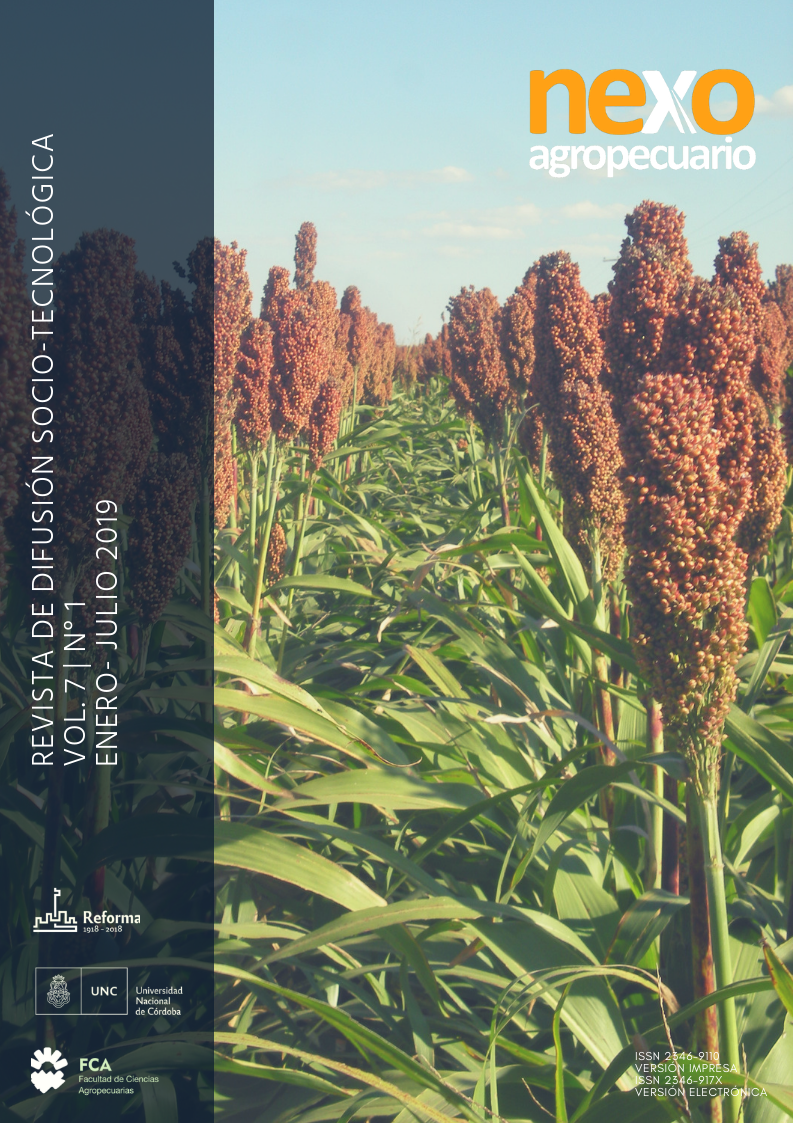Response of the wheat crop (Triticum Aestivum) to nitrogen and sulphur fertilization in Monte Maíz, Province of Córdoba.
Keywords:
fertilization, nitrogen, wheat, yield, qualityAbstract
Nitrogen (N) is the most relevant nutrient for wheat crop productivity. In addition, it can affect the commercial and industrial quality of the grain because it affects the hectolitric weight (PH) and the content of protein and gluten. On the other hand, sometimes sulphur (S) can also be a limiting factor. The objective of the present work was to evaluate the response of the wheat crop to different levels of nitrogen-sulfur fertilization in a lot located in Monte Maíz, Province of Córdoba. The variables analyzed were yield and its components, PH, humid gluten (GH) and protein. Four treatments were performed with different doses of N and S, and one unfertilized control. A greater yield was observed with the increase of the dose, associated to a greater number of grains per unit of surface. The quality of the grain, in relation to the unfertilized control, improved with the increase of the dose: the PH, the protein content and the GH increased from 1 to 4%, from 5 to 10% and from 2 to 6% respectively. The fertilization, in the range used in this trial, allowed to increase the economic result of the crop due to the higher yield and better quality of the obtained grain.
References
Bainotti C., Fraschina J., Salines J., Donaire G., Alberione E., Gómez D., Salines N., Conde B., Cuniberti M., Mir L., Reartes F., Paolini H. y Arce L. 2017. Informe de
Actualización Técnica en línea N° 7. Recuperado de https://inta.gob.ar/sites/default/files/inta_trigo_actual izacion2017.pdf#page=26 (26 de Septiembre de 2017,
15:00 hs).
Bolsa de Cereales de Córdoba. 2017. Anuario Meteorológico 2017. Recuperado de http://www.bccba.com.ar/dia/informes- agroclimaticos-137.html (02 de Febrero de 2018, 16:00 hs).
Calvo R. N., Echeverría H., Barbieri P. y Rozas S. H. 2006. Nitrógeno y azufre en trigo: ¿Rendimiento y proteína? Recuperado de http://www.ipni.net/publication/ia- lacs.nsf/0/4689D0DC7771AC5385257995007A4806/$FILE/2.pdf (29 de Enero de 2018, 16:30 hs).
Di Rienzo J.A., Casanoves F., Balzarini M.G., Gonzalez L.,Tablada M. y Robledo C.W. InfoStat versión 2016. Grupo InfoStat, FCA, Universidad Nacional de Córdoba, Argentina. http://www.infostat.com.ar
Echeverría, H. y Studdert G. 1998. El contenido de nitrógeno en la hoja bandera de trigo como predictivo del incremento de proteína en grano por aplicaciones de nitrógeno en espigazón. Recuperado de revista.agro.unlp.edu.ar/index.php/revagro/article/vie w/235(09 de Enero de 2018, 14:00 hs).
Falotico J., Studdert G. y Echeverría H. E. 1999. Nutrición nitrogenada del trigo bajo siembra directa y labranza convencional en condiciones de agricultura continua. Recuperado de http://suelos.org.ar/publicaciones/vol_17n2/falotico_9-20.pdf (04 de Enero de 2018, 10:00 hs).
Ferraris G. N., Mousegne F. J. y Urrutia J. 2015. Respuesta aditiva a la fertilización con nitrógeno, azufre y zinc en trigo. Recuperado de http://horizonteadigital.com/investigacion/ha68/6- 12.pdf(04 de Enero de 2018, 12:30 hs).
Márgenes Agropecuarios. 2018. Año 33, N° 391, pp 52, Enero de 2018.
Pagnan L., Errasquin L., Alladio R., Saavedra A., Pesaola G. y Bruno J. 2014. Evaluación de dosis crecientes de nitrógeno sobre el rendimiento y calidad comercial de los cultivares de trigo en el sudeste de Córdoba. Recuperado de https://inta.gob.ar/sites/default/files/script-tmp-inta_-_trigo nitrgeno_14.pdf (06 de Enero de 2018, 17:00 hs).
Downloads
Published
Issue
Section
License
Copyright (c) 2019 N Loste, M. A. Langone, G. Giambastiani

This work is licensed under a Creative Commons Attribution-NonCommercial-ShareAlike 4.0 International License.
Attribution - Non-Commercial - Share Alike (by-nc-sa): No commercial use of the original work or any derivative works is permitted, distribution of which must be under a license equal to that governing the original work.


